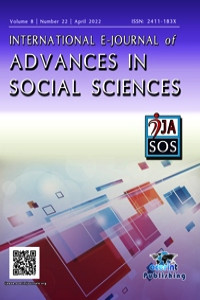Abstract
References
- Reference1 Abzianidze Zaza, Elashvili Ketevan, "Illustrated Encyclopedia of Symbols", Bakmi Publishing House, Tbilisi.
- Reference2 Bible, Georgian Patriarchate, Palitra L Publishing House, Tbilisi, 2013
- Reference3 Eliade Mircha, "Aspects of Myth", Publishing House, "Ilianus", "Tbilisi". 2009;
- Reference4 Lewis C.S. “The Magician’s Nephew ",publishing House "Books in Batumi", Batumi 2015;
- Reference5 Nozedar Adele, “Elements Encyclopedia of Secret Signs and Symbols”. The ultimate A-Z Guide from Alchemy to the Zodiac, published by “HarperElement”, HarperCollins E-Books, 2008;
- Reference6 Tavdgiridze Khatuna, "Mythological Archetypes", Aleph Publishing House, Tbilisi. 2021;
- Reference 7 Nemirovsky, A.I. "Myths and Legends of the Ancient East". Phoenix 2000.
THE COSMIC MODEL AND THE LITERARY TRANSFORMATION OF THE CREATION MYTH IN CLIVE LEWIS’ “THE CHRONICLES OF NARNIA”
Abstract
Written in the fantasy genre by Clive Lewis, the mythological paradigmatic text “The Chronicles of Narnia“ begins with the myth of creation and ends with eschatology – the end of the world. The creation of Narnia directly repeats the act of mythological creation with all its archetypal nuances.
1. “In the Chronicles of Narnia“ it is classically conveyed from darkness to word creation. “The Chronicles of Narnia“ is created with a cosmogonic model that is created with words and songs, chants. It is a parallel, literary version of the mythological cosmogony found in the Egyptian cosmogony of Memphis, Heliopolis, as well as the cosmogonies of the Indian Prajapati and the Maya, which was finally reinforced and loaded with the greatest religious authority by the biblical cosmogony of old perception. The supreme creator of Narnia is the lion Aslan. Aslan is not just an archetype of the god of mythological creation, the author of the “Chronicles of Narnia“ graced him with many Christian-theological symbolisms and strokes.
2. “The Chronicles of Narnia“ Consistently repeats the mythological cosmogonic archetypes that, after the creation of the universe, inevitably implies the enthronement of the King-Demiurge as an earthly double ordained by the supreme deity – the hypostasis of the deity himself.
3. Lewis’ characters are thrown with magical rings from our world – from Earth –in a fantasy world that has become an accomplice in the creation of a new world. All of them represent the three realms of the cosmos in the model architecture of the universe in a personified anthropomorphic form – the face of the supernatural is the lion Aslan, the face of the semisphere / earth is children, and the demonic representative of the underworld is the magician (who appears from another world).
“The Chronicles of Narnia” is built not only on the principle of three scales / spheres but also on the mediating link between these spheres: the archetype of the cosmic axis without which the cosmic model cannot take the form of a final solid structure.
Thus, in the Chronicles of Narnia, each character, as well as its dwelling or passage, approaches and expresses any part of the cosmic architecture of the universe. Such configuration of “Cosmos“ / Narnia and the characters seem to be a deliberate decision for Lewis – to fit everything into the traditional structure of the mythological cosmic model.
Keywords
Narnia archetypes Demiurge word creation creation from nowhere cosmic model three spheres portals cosmic axis. Narnia, archetypes, Demiurge, word creation, creation from nowhere, cosmic model, three spheres, portals, cosmic axis.
References
- Reference1 Abzianidze Zaza, Elashvili Ketevan, "Illustrated Encyclopedia of Symbols", Bakmi Publishing House, Tbilisi.
- Reference2 Bible, Georgian Patriarchate, Palitra L Publishing House, Tbilisi, 2013
- Reference3 Eliade Mircha, "Aspects of Myth", Publishing House, "Ilianus", "Tbilisi". 2009;
- Reference4 Lewis C.S. “The Magician’s Nephew ",publishing House "Books in Batumi", Batumi 2015;
- Reference5 Nozedar Adele, “Elements Encyclopedia of Secret Signs and Symbols”. The ultimate A-Z Guide from Alchemy to the Zodiac, published by “HarperElement”, HarperCollins E-Books, 2008;
- Reference6 Tavdgiridze Khatuna, "Mythological Archetypes", Aleph Publishing House, Tbilisi. 2021;
- Reference 7 Nemirovsky, A.I. "Myths and Legends of the Ancient East". Phoenix 2000.
Details
| Primary Language | English |
|---|---|
| Journal Section | Articles |
| Authors | |
| Publication Date | May 7, 2022 |
| Submission Date | February 11, 2022 |
| Published in Issue | Year 2022Volume: 8 Issue: 22 |
Contact: ijasosjournal@hotmail.com
The IJASOS Journal's site and its metadata are licensed under CC BY
Published and Sponsored by OCERINT International © 2015- 2025


